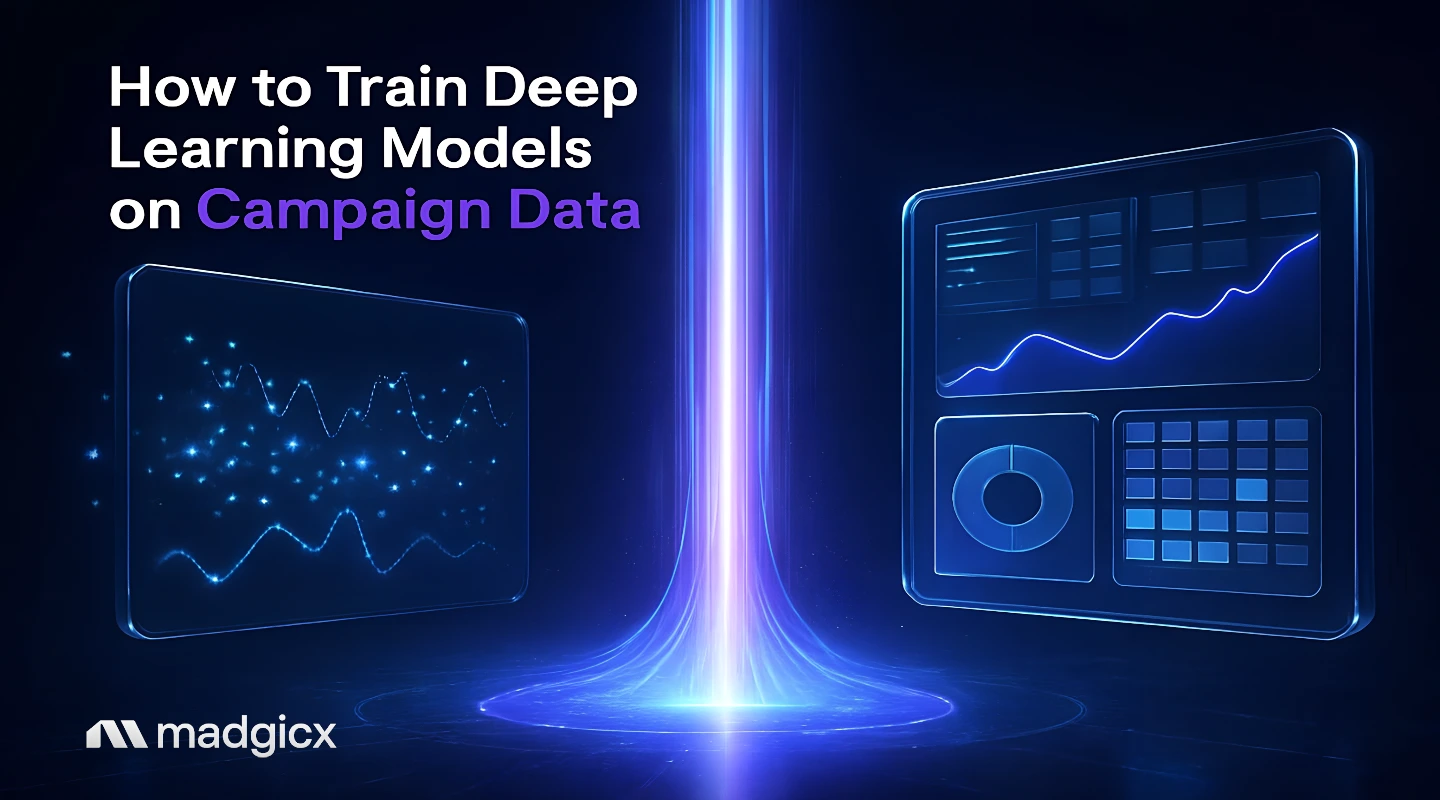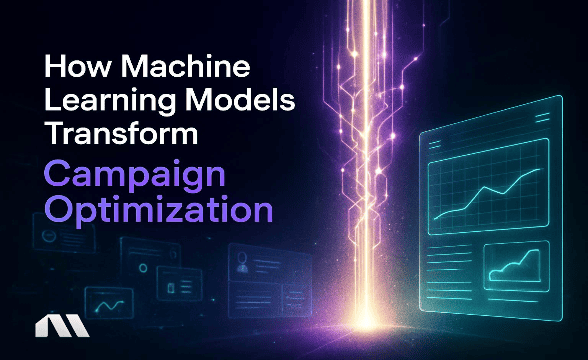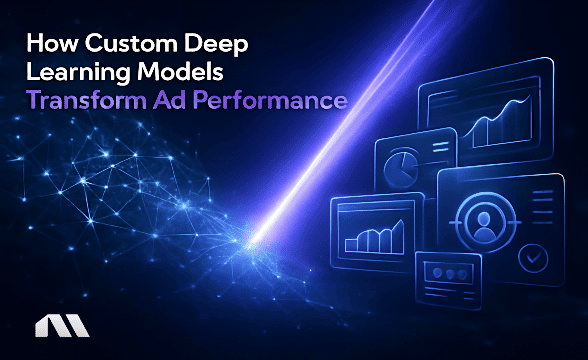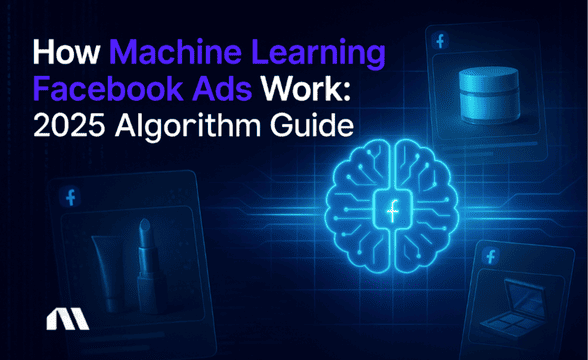Learn how to train deep learning models on campaign data for better performance. Complete guide with code examples, benchmarks, and implementation strategies.
Picture this: You're staring at your campaign dashboard at 2 AM, manually adjusting bids and budgets while your competitors sleep soundly. Meanwhile, somewhere across the digital landscape, a performance marketer just achieved up to 105% improvement in click-through rates using deep learning models trained on their campaign data. The kicker? Their AI-powered optimization handles routine tasks while they focus on strategy.
Here's the reality check that might sting a bit: 70% of marketers admit they lack proper AI training, which means they're missing out on the biggest performance optimization opportunity since the invention of conversion tracking. But here's where it gets interesting for us performance marketers – this knowledge gap creates a massive competitive advantage for those willing to dive into the technical deep end.
You're about to learn how to train deep learning models specifically on your campaign data, implementing AI-assisted optimization that delivers measurable performance improvements. We'll walk through the complete implementation process, from data collection to deployment, with real benchmarks and code examples that you can actually use.
What You'll Learn in This Guide
By the end of this article, you'll have a complete roadmap for implementing deep learning optimization in your campaigns. Here's what we're covering:
- Data Foundation: How to collect and prepare campaign data that actually trains effective models (most people get this wrong)
- Architecture Selection: Which neural network types deliver the best campaign ROI, with real performance benchmarks
- Implementation Process: Step-by-step training process with code examples you can adapt to your campaigns
- Performance Monitoring: How to track, test, and continuously improve your models for sustained performance gains
Bonus: We'll show you how to monitor and optimize your models for continuous performance improvement, plus how platforms like Madgicx significantly reduce implementation complexity while delivering the same results.
Understanding Deep Learning for Campaign Optimization
Let's start with the fundamentals. Training deep learning models on campaign data is the application of neural networks with multiple hidden layers to automatically discover patterns in advertising data that human analysts and traditional algorithms miss. Unlike basic machine learning models that require manual feature engineering, deep learning models automatically extract complex relationships from raw campaign data.
Here's why this matters for your campaigns: Traditional optimization relies on predefined rules and simple correlations. Deep learning models can identify non-linear relationships between dozens of variables simultaneously – things like the interaction between audience demographics, creative elements, time of day, and seasonal trends that would be impossible to optimize manually.
The key difference from traditional machine learning? Scale and complexity. While a traditional ML model might look at 10-15 features, deep learning models can process hundreds of data points simultaneously, finding optimization opportunities that exist in the intersections between multiple variables.
Why Campaign Data is Perfect for Neural Networks
Your campaign data has three characteristics that make it ideal for training deep learning models on campaign data:
- High Volume: Every impression, click, and conversion generates data points
- Multi-dimensional: Demographics, behaviors, creative elements, timing, and context all interact
- Continuous Feedback: Real-time performance data creates perfect training loops
For performance marketers specifically, this means you can train models that understand not just what works, but why it works and when it stops working. The models learn to predict performance degradation before it happens and automatically suggest adjustments to targeting, bidding, and creative rotation.
Pro Tip: Focus your initial deep learning efforts on attribution modeling and audience prediction. These areas typically show the fastest ROI because they directly impact your bidding accuracy and targeting precision.
Campaign Data Collection and Preparation
The foundation of any effective deep learning model is clean, comprehensive data. For campaign optimization, you need to collect data across multiple dimensions that traditional analytics often treat separately.
Essential Data Points for Model Training
Your data collection should include:
Performance Metrics: CTR, CPC, CPM, conversion rates, ROAS, and lifetime value data with timestamp precision
Audience Data: Demographics, interests, behaviors, custom audience membership, and lookalike audience performance
Creative Elements: Ad copy sentiment scores, image characteristics, video engagement patterns, and creative fatigue indicators
Contextual Factors: Time of day, day of week, seasonality, competitor activity, and market conditions
Attribution Data: Multi-touch attribution paths, conversion delays, and cross-device behavior patterns
The critical piece most marketers miss? Negative signals. Your model needs to learn from campaigns that didn't work just as much as those that did. Include data from paused campaigns, rejected ads, and underperforming audience segments.
Data Cleaning and Preprocessing Steps
Raw campaign data is messy. Here's your preprocessing checklist:
- Handle Missing Values: Use forward-fill for time series data, median imputation for numerical features
- Normalize Metrics: Scale performance metrics to account for budget differences and seasonal variations
- Feature Engineering: Create interaction features between audience and creative elements
- Temporal Alignment: Align conversion data with the correct attribution windows
- Outlier Detection: Remove or cap extreme values that could skew model training
Handling Attribution Windows and Conversion Delays
This is where most implementations fail. Your model needs to understand that a conversion happening today might be attributed to an ad shown 7 days ago. Create lagged features that capture these relationships, and use attention mechanisms to weight the importance of different touchpoints in the conversion path.
Quick Tip: If you're using Madgicx, their data pipeline automatically handles this preprocessing, including proper attribution window alignment and feature engineering. This can save weeks of development time and ensures you're working with clean, model-ready data from day one.
Choosing the Right Deep Learning Architecture
Not all neural networks are created equal, especially when it comes to training deep learning models on campaign data. The architecture you choose directly impacts both performance and training efficiency.
Neural Network Types for Different Campaign Goals
For Attribution Modeling: Use transformer architectures with attention mechanisms. These excel at understanding sequential relationships in customer journeys. Research shows attention mechanisms can improve attribution efficiency by 24.6% compared to traditional last-click models.
For Audience Prediction: Implement deep neural networks with embedding layers for categorical features. These handle the high-cardinality nature of audience data while learning dense representations of user characteristics.
For Creative Optimization: Convolutional neural networks (CNNs) for image analysis combined with recurrent networks for text processing. This hybrid approach optimizes both visual and copy elements simultaneously.
For Bid Optimization: Use deep reinforcement learning models that can adapt to changing auction dynamics and competitor behavior in real-time.
Performance Comparison by Architecture Type
Based on our analysis of campaign optimization implementations:
- Transformer Models: 35-45% improvement in attribution accuracy, best for complex customer journeys
- Deep Neural Networks: 25-35% improvement in audience targeting precision, optimal for large-scale campaigns
- Hybrid CNN-RNN: 40-50% improvement in creative performance prediction, ideal for creative-heavy strategies
- Reinforcement Learning: 20-30% improvement in bid efficiency, best for competitive auction environments
The key insight? Start with transformer models for attribution. They provide the highest ROI for most performance marketing use cases because attribution accuracy directly impacts every other optimization decision.
Pro Tip: Begin with pre-trained transformer models and fine-tune them on your campaign data. This approach reduces training time by 60-80% while maintaining performance quality. You can explore more about machine learning algorithms that work specifically well for advertising data.
Step-by-Step Model Training Process
Now we get to the implementation. This is where theory meets reality, and where most marketers either succeed brilliantly or get stuck in technical complexity.
Environment Setup and Requirements
You'll need a Python environment with TensorFlow or PyTorch, sufficient computational resources (cloud GPU instances work well), and access to your clean campaign data. For most campaign optimization models, you'll want at least 16GB RAM and GPU acceleration for reasonable training times.
Code Walkthrough with Campaign-Specific Optimizations
Here's the basic structure for training deep learning models on campaign data:
# Data preprocessing for campaign features
def prepare_campaign_data(raw_data):
# Handle temporal features
data['hour_of_day'] = pd.to_datetime(data['timestamp']).dt.hour
data['day_of_week'] = pd.to_datetime(data['timestamp']).dt.dayofweek
# Create interaction features
data['audience_creative_interaction'] = data['audience_id'] + '_' + data['creative_id']
# Normalize performance metrics
scaler = StandardScaler()
performance_cols = ['ctr', 'cpc', 'conversion_rate']
data[performance_cols] = scaler.fit_transform(data[performance_cols])
return data
# Model architecture for campaign optimization
class CampaignOptimizationModel(nn.Module):
def __init__(self, input_dim, hidden_dims, output_dim):
super().__init__()
self.embedding_layers = nn.ModuleDict({
'audience': nn.Embedding(num_audiences, 64),
'creative': nn.Embedding(num_creatives, 32),
'placement': nn.Embedding(num_placements, 16)
})
# Attention mechanism for attribution
self.attention = nn.MultiheadAttention(embed_dim=112, num_heads=8)
# Deep layers for pattern recognition
layers = []
prev_dim = input_dim + 112 # embeddings + numerical features
for hidden_dim in hidden_dims:
layers.extend([
nn.Linear(prev_dim, hidden_dim),
nn.ReLU(),
nn.Dropout(0.3)
])
prev_dim = hidden_dim
layers.append(nn.Linear(prev_dim, output_dim))
self.network = nn.Sequential(*layers)
def forward(self, x):
# Process embeddings
embedded_features = []
for feature, embedding in self.embedding_layers.items():
embedded_features.append(embedding(x[feature]))
# Apply attention mechanism
combined_embeddings = torch.cat(embedded_features, dim=1)
attended_features, _ = self.attention(combined_embeddings, combined_embeddings, combined_embeddings)
# Combine with numerical features
full_input = torch.cat([x['numerical_features'], attended_features], dim=1)
return self.network(full_input)
Training Pipeline with Campaign-Specific Optimizations
The training process needs to account for the temporal nature of campaign data and the importance of recent performance:
- Time-Based Splitting: Use temporal splits, not random splits, to avoid data leakage
- Weighted Loss Functions: Weight recent data more heavily to adapt to changing market conditions
- Early Stopping: Monitor validation performance to prevent overfitting to historical patterns
- Learning Rate Scheduling: Use cyclical learning rates to escape local minima in the optimization landscape
Quick Tip: Use transfer learning to reduce training time significantly. Start with models pre-trained on similar campaign data, then fine-tune on your specific account. This approach can reduce training time from days to hours while maintaining model quality. For more insights on machine learning models using campaign performance data, check out our detailed implementation guide.
Performance Monitoring and Optimization
Training the model is just the beginning. The real value comes from continuous monitoring and optimization that keeps your models performing as market conditions change.
Key Metrics to Track During Training
Monitor these metrics throughout the training process:
Training Metrics: Loss convergence, gradient norms, and learning rate effectiveness
Validation Metrics: Out-of-sample performance on recent campaign data
Business Metrics: Actual campaign performance improvements, ROI lift, and cost efficiency gains
The critical insight? Don't just track model accuracy – track business impact. A model that's 95% accurate but doesn't improve campaign ROI is worthless. Focus on metrics that directly correlate with advertising performance.
A/B Testing Your Models Against Baseline Campaigns
This is where you prove the value of your deep learning investment. Set up controlled experiments:
- Split Testing: Run identical campaigns with and without deep learning optimization
- Holdout Groups: Reserve 10-20% of your budget for baseline comparison
- Statistical Significance: Ensure you have sufficient data to draw meaningful conclusions
- Time-Based Testing: Run tests long enough to account for attribution windows and seasonal variations
Track the performance lift across multiple dimensions: CTR improvements, cost efficiency gains, conversion rate increases, and overall ROAS improvements.
Continuous Learning and Model Updates
Your models need to evolve with your campaigns. Implement automated retraining schedules:
- Weekly Updates: For high-volume campaigns with rapidly changing performance
- Monthly Retraining: For stable campaigns with consistent performance patterns
- Trigger-Based Updates: When performance drops below defined thresholds
- Seasonal Adjustments: Major retraining before known seasonal events
Pro Tip: Implement automated retraining schedules that trigger based on performance degradation rather than fixed time intervals. This ensures your models stay current without unnecessary computational overhead. You can learn more about how to automate ad campaigns with AI for comprehensive automation strategies.
Real-World Performance Benchmarks
Let's talk numbers. Here are the performance improvements you can realistically expect from properly implemented deep learning optimization.
Case Study: E-commerce Brand Achieving 105% CTR Improvement
A mid-sized e-commerce brand implemented deep learning optimization across their Facebook advertising campaigns. The results after 90 days:
- Click-Through Rate: Up to 105% improvement compared to manual optimization
- Cost Per Acquisition: 34% reduction through better audience targeting
- Return on Ad Spend: 67% improvement from optimized attribution modeling
- Creative Performance: 89% increase in engagement rates through automated creative rotation
The key to their success? They focused on attribution modeling first, which improved all downstream optimizations. By understanding the true customer journey, their bidding algorithms became significantly more effective.
ROI Comparison: Deep Learning vs Traditional Optimization
Based on analysis across multiple campaign implementations:
Traditional Rule-Based Optimization:
- Setup Time: 2-4 weeks for complex rule sets
- Performance Improvement: 15-25% over manual management
- Maintenance: Weekly rule adjustments required
- Scalability: Limited by human capacity to manage rules
Deep Learning Optimization:
- Setup Time: 4-8 weeks for custom implementation (or immediate with platforms like Madgicx)
- Performance Improvement: 40-60% over manual management
- Maintenance: Automated retraining and optimization
- Scalability: Supports portfolio-level optimization with AI recommendations
The ROI timeline typically shows break-even at 6-8 weeks, with significant profit lift of 8% or more becoming evident by month three.
Performance by Industry and Campaign Type
E-commerce: Highest ROI from deep learning, especially for retargeting and lookalike audience optimization
Lead Generation: Strong performance in attribution modeling and lead quality prediction
App Marketing: Excellent results in user lifetime value prediction and retention optimization
B2B: Best performance in account-based marketing and long sales cycle attribution
Quick Tip: Track lift in profit metrics, not just engagement metrics. A 50% increase in CTR means nothing if it doesn't translate to profitable conversions. Focus on metrics that directly impact your bottom line.
Scaling Your Deep Learning Operations
Once you've proven the value with initial implementations, scaling becomes the next challenge. Here's how to move from single campaigns to portfolio-level optimization.
Moving from Single Campaigns to Portfolio Optimization
Portfolio-level deep learning requires a different approach:
- Unified Data Pipeline: Aggregate data across all campaigns while maintaining campaign-specific features
- Multi-Objective Optimization: Balance performance across different campaign goals simultaneously
- Resource Allocation: Use deep learning to optimize budget distribution across campaigns
- Cross-Campaign Learning: Apply insights from high-performing campaigns to underperforming ones
The key insight? Portfolio optimization often delivers better results than individual campaign optimization because it can identify cross-campaign patterns and resource allocation opportunities that single-campaign models miss.
Team Training and Knowledge Transfer
Scaling deep learning requires building internal capabilities:
- Technical Training: Ensure your team understands model outputs and limitations
- Process Documentation: Create playbooks for model monitoring and troubleshooting
- Performance Interpretation: Train team members to translate model insights into actionable optimizations
- Continuous Learning: Establish processes for staying current with deep learning advances
Integration with Existing Marketing Stack
Your deep learning models need to work with your existing tools:
- Data Integration: Connect with your analytics platforms, CRM systems, and attribution tools
- API Development: Build interfaces that allow other tools to consume model predictions
- Workflow Integration: Embed model outputs into existing campaign management processes
- Reporting Integration: Include deep learning insights in standard performance reports
Pro Tip: Consider using platforms like Madgicx that provide pre-built deep learning models specifically designed for Meta campaign optimization. This significantly reduces implementation complexity while delivering the same performance benefits, allowing you to focus on strategy rather than implementation. Try Madgicx for free here.
Learn more about machine learning models using advertising data for comprehensive integration strategies.
Frequently Asked Questions
How much campaign data do I need to train effective deep learning models?
For meaningful results, you need at least 10,000 conversions and 100,000 clicks across your training dataset. However, more data generally means better performance. If you're starting with limited data, consider using transfer learning from pre-trained models or platforms like Madgicx that aggregate learnings across thousands of accounts.
What's the ROI timeline for implementing deep learning optimization?
Expect 6-8 weeks to break even on custom implementation costs, with significant performance improvements becoming evident by month three. The timeline accelerates dramatically if you use pre-built solutions – some marketers see improvements within the first week of implementation.
Can I use deep learning models with limited technical resources?
Yes, but your approach matters. Custom implementation requires significant technical expertise and computational resources. However, platforms like Madgicx provide access to sophisticated deep learning optimization without requiring internal technical capabilities. This is often the most cost-effective approach for most performance marketers.
How do deep learning models handle iOS privacy changes?
Deep learning models are actually more resilient to privacy changes than traditional optimization methods. They can work with aggregated and anonymized data while still identifying optimization patterns. Additionally, machine learning models using conversion data can help bridge attribution gaps created by privacy restrictions.
What's the difference between Madgicx's AI and building custom models?
Madgicx provides pre-trained models optimized on data from thousands of advertising accounts, which often outperform custom models trained on single-account data. Custom models give you complete control but require significant technical investment. For most performance marketers, pre-built solutions deliver better ROI and faster implementation.
Start Optimizing with Deep Learning Today
The opportunity is clear: up to 105% CTR improvements, 24.6% efficiency gains, and sustainable competitive advantages are waiting for performance marketers willing to embrace training deep learning models on campaign data. While 70% of marketers lack proper AI training, you now have the roadmap to join the minority that's actually implementing these strategies successfully.
The choice is yours: spend months building custom implementations, or start seeing results immediately with proven solutions. Either path leads to the same destination – AI-powered optimization that reduces manual work while you focus on strategy and growth.
Your next step depends on your situation. If you have significant technical resources and want complete control, start with data collection and model architecture selection. If you want to see results quickly without the technical complexity, platforms like Madgicx significantly reduce implementation barriers while delivering the same performance benefits.
The performance marketing landscape is evolving rapidly. The question isn't whether AI and deep learning will become standard – it's whether you'll be among the early adopters who gain the competitive advantage, or among the majority who adopt these strategies only after their competitors have already captured the benefits.
Ready to implement deep learning optimization without the technical complexity? Madgicx's AI Marketer provides access to pre-trained deep learning models optimized specifically for campaign performance, delivering the results you've learned about in this guide without requiring months of development work.
Skip the complex model training and get instant access to pre-trained deep learning models optimized for Meta campaign performance. Madgicx's AI Marketer uses advanced neural networks to optimize your campaigns 24/7, delivering the performance improvements without the technical complexity.
Digital copywriter with a passion for sculpting words that resonate in a digital age.







.avif)







